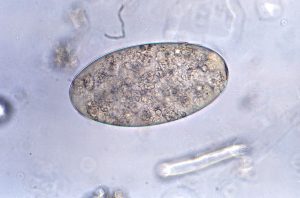 1979
1979
Dr. Mae Melvin
Under a high magnification of 400X, this photomicrograph revealed some of the ultrastructural morphology exhibited by a trematode, Fasciolopsis buski, egg, which is described as broadly ellipsoidal, operculated and measuring 130µm to 150µm long, by 60 µm to 90µm wide. These eggs are unembryonated when passed in feces. The eggs of F. buski can be difficult to distinguish from Fasciola hepatica, although the abopercular end of the latter often has a roughened or irregular area.
Clinical Features:Most infections are light and asymptomatic. In heavier infections, symptoms include diarrhea, abdominal pain, fever, ascites, anasarca and intestinal obstruction.
Laboratory Diagnosis:
Microscopic identification of eggs, or more rarely of the adult flukes, in the stool or vomitus is the basis of specific diagnosis. The eggs are indistinguishable from those of Fasciola hepatica.
Fasciolopsis buski is the largest intestinal fluke that infects humans and causes fasciolopsiasis, a parasitic disease prevalent in parts of Asia, including China, India, and Thailand. The life cycle of the parasite involves freshwater snails, which release larvae that attach to aquatic plants. Humans and pigs become infected when they consume raw or undercooked aquatic plants such as water chestnuts, lotus, or water bamboo that are contaminated with the parasite’s encysted larvae (metacercariae).
Once ingested, the larvae emerge in the intestines, where they mature into adult flukes. These adult worms can reach lengths of up to 7.5 cm and attach to the intestinal wall, where they cause localized inflammation and damage. In mild cases, fasciolopsiasis may present with symptoms such as diarrhea, nausea, and abdominal pain. However, in severe infections, especially with large worm burdens, the parasite can cause intestinal obstruction, malnutrition, and edema due to impaired absorption of nutrients.
Treatment for fasciolopsiasis involves antiparasitic medications such as praziquantel or triclabendazole, which effectively kill the adult worms. Preventing the disease requires avoiding the consumption of raw or undercooked aquatic plants, improving sanitation to break the parasite’s life cycle, and controlling the spread of infection in pigs, which serve as an important reservoir.



